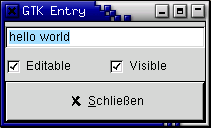10.8. Text Entries
The Entry widget allows text to be typed and displayed in a single line text box. The text may be set with function calls that allow new text to replace, prepend or append the current contents of the Entry widget.
Create a new Entry widget with the following function.
GtkWidget *gtk_entry_new( void );
The next function alters the text which is currently within the Entry widget.
void gtk_entry_set_text( GtkEntry *entry,
const gchar *text );The function gtk_entry_set_text() sets the contents of the Entry widget, replacing the current contents. Note that the class Entry implements the Editable interface (yes, gobject supports Java-like interfaces) which contains some more functions for manipulating the contents.
The contents of the Entry can be retrieved by using a call to the following function. This is useful in the callback functions described below.
const gchar *gtk_entry_get_text( GtkEntry *entry );
The value returned by this function is used internally, and must not be freed using either free() or g_free().
If we don't want the contents of the Entry to be changed by someone typing into it, we can change its editable state.
void gtk_editable_set_editable( GtkEditable *entry,
gboolean editable );The function above allows us to toggle the editable state of the Entry widget by passing in a TRUE or FALSE value for the editable argument.
If we are using the Entry where we don't want the text entered to be visible, for example when a password is being entered, we can use the following function, which also takes a boolean flag.
void gtk_entry_set_visibility( GtkEntry *entry,
gboolean visible );A region of the text may be set as selected by using the following function. This would most often be used after setting some default text in an Entry, making it easy for the user to remove it.
void gtk_editable_select_region( GtkEditable *entry,
gint start,
gint end );If we want to catch when the user has entered text, we can connect to the activate or changed signal. Activate is raised when the user hits the enter key within the Entry widget. Changed is raised when the text changes at all, e.g., for every character entered or removed.
The following code is an example of using an Entry widget.

#include <stdio.h>
#include <stdlib.h>
#include <gtk/gtk.h>
static void enter_callback( GtkWidget *widget,
GtkWidget *entry )
{
const gchar *entry_text;
entry_text = gtk_entry_get_text (GTK_ENTRY (entry));
printf ("Entry contents: %s\n", entry_text);
}
static void entry_toggle_editable( GtkWidget *checkbutton,
GtkWidget *entry )
{
gtk_editable_set_editable (GTK_EDITABLE (entry),
GTK_TOGGLE_BUTTON (checkbutton)->active);
}
static void entry_toggle_visibility( GtkWidget *checkbutton,
GtkWidget *entry )
{
gtk_entry_set_visibility (GTK_ENTRY (entry),
GTK_TOGGLE_BUTTON (checkbutton)->active);
}
int main( int argc,
char *argv[] )
{
GtkWidget *window;
GtkWidget *vbox, *hbox;
GtkWidget *entry;
GtkWidget *button;
GtkWidget *check;
gint tmp_pos;
gtk_init (&argc, &argv);
/* create a new window */
window = gtk_window_new (GTK_WINDOW_TOPLEVEL);
gtk_widget_set_size_request (GTK_WIDGET (window), 200, 100);
gtk_window_set_title (GTK_WINDOW (window), "GTK Entry");
g_signal_connect (G_OBJECT (window), "destroy",
G_CALLBACK (gtk_main_quit), NULL);
g_signal_connect_swapped (G_OBJECT (window), "delete_event",
G_CALLBACK (gtk_widget_destroy),
G_OBJECT (window));
vbox = gtk_vbox_new (FALSE, 0);
gtk_container_add (GTK_CONTAINER (window), vbox);
gtk_widget_show (vbox);
entry = gtk_entry_new ();
gtk_entry_set_max_length (GTK_ENTRY (entry), 50);
g_signal_connect (G_OBJECT (entry), "activate",
G_CALLBACK (enter_callback),
(gpointer) entry);
gtk_entry_set_text (GTK_ENTRY (entry), "hello");
tmp_pos = GTK_ENTRY (entry)->text_length;
gtk_editable_insert_text (GTK_EDITABLE (entry), " world", -1, &tmp_pos);
gtk_editable_select_region (GTK_EDITABLE (entry),
0, GTK_ENTRY (entry)->text_length);
gtk_box_pack_start (GTK_BOX (vbox), entry, TRUE, TRUE, 0);
gtk_widget_show (entry);
hbox = gtk_hbox_new (FALSE, 0);
gtk_container_add (GTK_CONTAINER (vbox), hbox);
gtk_widget_show (hbox);
check = gtk_check_button_new_with_label ("Editable");
gtk_box_pack_start (GTK_BOX (hbox), check, TRUE, TRUE, 0);
g_signal_connect (G_OBJECT (check), "toggled",
G_CALLBACK (entry_toggle_editable), (gpointer) entry);
gtk_toggle_button_set_active (GTK_TOGGLE_BUTTON (check), TRUE);
gtk_widget_show (check);
check = gtk_check_button_new_with_label ("Visible");
gtk_box_pack_start (GTK_BOX (hbox), check, TRUE, TRUE, 0);
g_signal_connect (G_OBJECT (check), "toggled",
G_CALLBACK (entry_toggle_visibility), (gpointer) entry);
gtk_toggle_button_set_active (GTK_TOGGLE_BUTTON (check), TRUE);
gtk_widget_show (check);
button = gtk_button_new_from_stock (GTK_STOCK_CLOSE);
g_signal_connect_swapped (G_OBJECT (button), "clicked",
G_CALLBACK (gtk_widget_destroy),
G_OBJECT (window));
gtk_box_pack_start (GTK_BOX (vbox), button, TRUE, TRUE, 0);
GTK_WIDGET_SET_FLAGS (button, GTK_CAN_DEFAULT);
gtk_widget_grab_default (button);
gtk_widget_show (button);
gtk_widget_show (window);
gtk_main();
return 0;
}